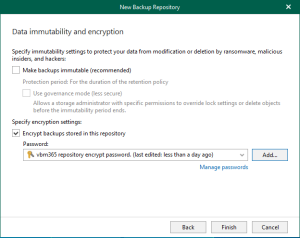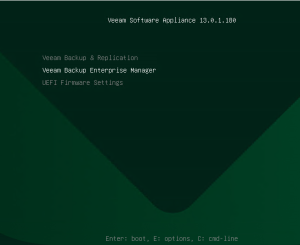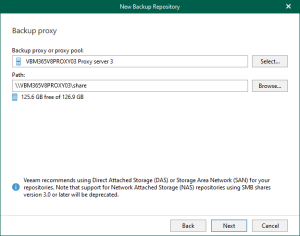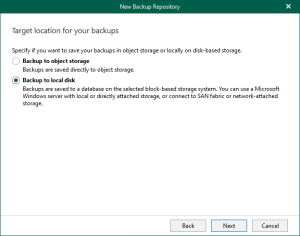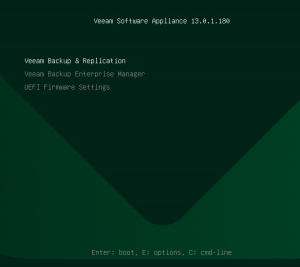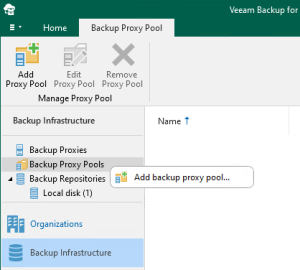

Veeam released the Backup & Replication v10 on February, and with it comes over 150+ anticipated new features and enhancements. Veeam now also have support for the option “Copy backups to object storage as soon as they are created” at SOBR Repositories settings, it will create additional copy of your backups for added redundancy by having all backups copied to the capacity tier as soon as they are created on the performance tier. Let’s follow steps to configure it.
-
Login to Azure portal, click Create resource.

-
On the New page, select Storage account – blob, file, table, queue.

-
On the Storage account page, click Create.

-
On the Create storage account page, select Basics and configure as follow and then click Next:Networking:
Subscription: select your Azure subscription, e.g. Pay-As-You-Go.
Resource group: click create new and enter a name for the resource name and then click OK.

Storage account name: enter a name for the storage account.
Location: select your location.
Performance: select Standard.
Account kind: select Storage V2 (general purpose v2).
Replication: select Locally-redundant storage (LRS).
Access tier (default): select Cool.

-
On the Networking page, select Public endpoint (all network) and then click Next:Advance.

-
On the Advanced page, configure as follow and then click Next:Tags.
Secure transfer required: select Enabled.
Large file shares: select Disabled.
Blob soft delete: select Disabled.
Hierarchical namespace: select Disabled.

-
On the Tags page, click Next:Review + create.

-
On the Review + create page, make sure Validation passed and then click Create.

-
It may need few mins to create the new storage account, click Go to resource after the storage account is ready.

-
On the created storage account page, select Access keys.

-
On the Access keys page, copy Storage account name and key of key1, we need them for Veeam storage repository settings later.

-
On the created storage account page, select Containers.

-
On the Containers page, click +Container.

-
On the new container page, enter a name for your new container, select Private (no anonymous access) as Public access level and then click OK.

-
Login to Veeam server and open Backup & Replication console and then click Connect.

-
On the Home page, select BACKUP INFRASTRUCTURE.

-
On the BACKUP INFRASTRUCTURE page, select Backup Repositories and click Add Repository…

-
On the Add Backup Repository page, select Object storage.

-
On the Object Storage page, select Microsoft Azure Blob Storage.

-
On the Microsoft Azure Blob Storage page, select Azure Blob Storage.

-
On the Name page, enter a name for Azure Blob repository, click Next.

-
On the Account page, click Add on Credentials item.

-
Paste Azure storage account name as Account and paste key1 as Shared key (you copied them from Azure storage account Access key).

- On the Account page, select Azure Global (Standard) as Region.
-
Select Use the following gateway server and then select a gateway server as proxy server and then click Next.

-
On the Container page, select the new created Azure Blob container from Container.

-
Click Folder Browse, select the new created Azure Blob container and then click New Folder to create folder and then click OK.


-
You also can select Limit object storage to help you control your cloud storage spend, but here I am going to keep the default settings (uncheck) and then click Next.

-
On the Summary page, click Finish.

-
On the BACKUP INFRASTRUCTURE page, select Backup Repositories and click Add Repository…

-
On the Add Backup Repository page, select Direct attached storage.

-
On the Direct Attached Storage page, select Microsoft Windows.

-
On the Name page, enter a name for local repository, click Next.

-
On the Server page, select your storage server from local repository server. Click Populate and then select the Drive from path, click Next.

-
On the Repository page, click Browse…

-
On the select folders page, click New Folder.

-
Create AzureBackup folder, click OK.

-
On the Repository page, click Advanced….

-
On the Storage Compatibility Settings, select Use per-VM backup files, click OK.

-
On the Repository page, click Next.

-
On the Mount Server, select your storage server as Mount server, click Next.

-
On the Review page, click Apply.

-
On the Apply page, make sure all messages are green (show successfully), click Next.

-
On the Summary page, click Finish.

-
On the BACKUP INFRASTRUCTURE, select Scale-out Repositories, click Add Scale-out Repository.

Note: please make sure you are using Veeam Backup & Replication Enterprise or Enterprise Plus if you don’t see the settings.
-
On the Name page, enter name for Scale-out backup Repository, click Next.

-
On the Performance Tier page, click Add….

-
On the Extents page, select the AzureBackup_local Repository as Extents and click OK.

-
On the Performance Tier page, click Advanced.

-
On the Advanced Settings, select Use per-VM backup files (recommended), click OK, and then click Next.


-
On the Placement Policy page, select Data locality, click Next.

-
On the Capacity Tier page, click Extend scale-out backup repository capacity with object storage and select Azure Object storage repository.

-
On the Capacity Tier page, click Windows…to define time windows when uploading to object storage is allowed.

-
If you need offload file to Azure Blob at working hours time periods, please use Global Network Traffic Rules to Throttle network traffic.


-
Select Copy backups to object storage as soon as they are created. This is a new feature of v10, it will create additional copy of your backups for added redundancy by having all backups copied to the capacity tier as soon as they are created on the performance tier.

-
On the Capacity Tier page, select Move Backups to object storage…. and keep the default setting as 30 days, you can change it if you need it.

-
You also can click Override…. to get more options for moving oldest file to Azure Blob, click OK.

Note: Every 4 hours Veeam collects the backup data from the extents and transfers it to object storage according to policies that define how and when such data should be offloaded
-
You can also define a master password that will be used to encrypt data uploaded to object storage, click Apply.

Note: This password will be used for encrypting all data moved to the cloud object storage.
-
On the Summary page, click Finish.

-
On the Home page, select Backup (under Jobs).

-
Click Backup Job and select Virtual machine….

-
On the Name page, type a name for the new backup job, click Next.

-
On the Virtual Machines page, click Add….

-
Select the Host or Virtual machine which you would like to backup, in my case, I selected the host, Veeam will backup all Virtual Machines of the host, click Add.

-
On the Virtual Machines page, click Next.

-
On the storage page, select Azure Blob Scale-out Backup Repository as the Backup repository.

-
In Veeam B&R v10, you can configure GFS retention policy settings for the backup job, on the Storage page, select Keep certain full backups longer for archival purpose, click Configure….


-
In the Veeam B&R v10, there are two retention policy settings options for restore points -restore points and days.

-
On the Guest Processing page, If you add to the backup job VMs running VSS-aware applications, you can enable application-aware processing to create a transactionally consistent backup, in my case, I won’t enable it, click Next.

-
On the Schedule page, select to run the backup job manually or schedule the job to run on a regular basis, click Apply.

-
On the Summary page, click Finish.

-
Select the new created backup job and click Start.

-
When you check the jobs status, it will start offload to Azure blob after a vm backup completed.


-
You also can check the Archive folder structure at Azure Blob.

Hope you enjoy this post.
Cary Sun
Twitter: @SifuSun
Author: Cary Sun
Cary Sun has a wealth of knowledge and expertise in data center and deployment solutions. As a Principal Consultant, he likely works closely with clients to help them design, implement, and manage their data center infrastructure and deployment strategies.
With his background in data center solutions, Cary Sun may have experience in server and storage virtualization, network design and optimization, backup and disaster recovery planning, and security and compliance management. He holds CISCO CERTIFIED INTERNETWORK EXPERT (CCIE No.4531) from 1999. Cary is also a Microsoft Most Valuable Professional (MVP), Microsoft Azure MVP, Veeam Vanguard and Cisco Champion. He is a published author with several titles, including blogs on Checkyourlogs.net, and the author of many books.
Cary is a very active blogger at checkyourlogs.net and is permanently available online for questions from the community. His passion for technology is contagious, improving everyone around him at what they do.
Blog site: https://www.checkyourlogs.net
Web site: https://carysun.com
Blog site: https://gooddealmart.com
Twitter: @SifuSun
in: https://www.linkedin.com/in/sifusun/
Amazon Author: https://Amazon.com/author/carysun
